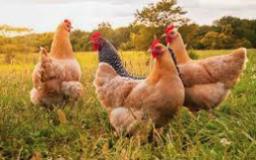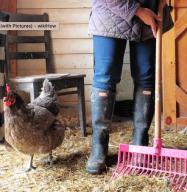Feeder & Waterer Essentials

Choosing the Right Setup for Your Flock
If you’re a proud chicken owner in South Africa, then you already know that raising healthy, happy chickens goes beyond just providing food and water. The setup you choose for your flock’s feeder and waterer plays a critical role in their well-being. Whether you have a small backyard flock or a larger one, choosing the right Chicken Accessories can make a world of difference in your chickens’ health, productivity, and happiness.
As a pet owner, you want to ensure your feathered friends have everything they need to thrive. In this article, we’ll walk you through the essentials for choosing the perfect feeder and waterer setup for your chickens. By the end, you’ll be ready to make informed decisions that benefit both you and your flock!
Understanding Chicken Feeding Needs
Before you start shopping for Chicken Accessories, it’s important to understand what your chickens need in terms of food and water. Chickens are omnivores, meaning they eat a variety of foods. Their diet should include grains, seeds, vegetables, and proteins, with access to grit and calcium for proper digestion and egg-laying.
When it comes to food and water, there are a few key points to keep in mind:
- Freshness: Chickens need constant access to fresh food and clean water. Stale or contaminated food and water can lead to health problems.
- Quantity: Your flock’s size will determine how much food and water they need. On average, a single chicken will drink between 500ml to 700ml of water a day, depending on the weather and diet. As for food, chickens generally eat around 120g to 150g of feed per day.
- Accessibility: Make sure that all of your chickens can reach their food and water. If they can’t, some might get left out, leading to stress and competition.
Once you understand these needs, it’s time to look into the Chicken Accessories that will best suit your flock.
Choosing the Right Feeders for Your Chickens
The right feeder will depend on a few factors: the number of chickens in your flock, the size of your coop, and whether you’re dealing with chicks, hens, or roosters. Here are the most common types of feeders you’ll encounter:
1. Trough Feeders
Trough feeders are the most basic and commonly used type of chicken feeder. They usually consist of a long, open container where the food is poured. These are great for small flocks and are easy to clean and refill. However, they can be messy, as chickens tend to scatter feed everywhere.
Advantages:
- Simple and affordable
- Easy to refill
- Easy to clean
Disadvantages:
- Feed can get spilled and wasted
- Not ideal for free-range chickens, as they’ll scatter food quickly
2. Hopper Feeders
Hopper feeders are designed to hold larger quantities of feed and release it slowly as the chickens eat. They are usually gravity-fed and have a built-in mechanism to prevent spillage. Hopper feeders are great for larger flocks, as they reduce the need for frequent refills.
Advantages:
- Minimises waste
- Ideal for larger flocks
- Helps to keep the feed dry
Disadvantages:
- More expensive than trough feeders
- May require more maintenance
3. Nipple Feeders
Nipple drinkers are an excellent choice for keeping water clean and free of contamination. They consist of small nipples that chickens peck to release water, and they’re perfect for preventing spillage or fouling. You’ll often find nipple waterers used in automated systems, which can be especially helpful for larger flocks.
Advantages:
- Reduces water wastage
- Keeps water clean
- Ideal for larger flocks or free-range chickens
Disadvantages:
- Can be more expensive to set up
- Requires regular maintenance to ensure water flow
4. Automatic Feeders
Automatic feeders can be a game-changer for busy chicken owners. These feeders are designed to release food into a trough or tray at predetermined intervals. They are often used in combination with automated watering systems, making it easy to ensure that your chickens have access to fresh food and water even when you're not around.
Advantages:
- Ideal for larger flocks
- Reduces the need for constant attention
- Ensures consistent feeding schedules
Disadvantages:
- More expensive
- May require regular calibration
Selecting the Best Waterers for Your Flock
Just like choosing the right feeder, selecting the best waterer for your chickens is key to their health. Water is the most important nutrient for chickens, and it’s essential that they have constant access to clean, fresh water. Here are the most popular types of waterers:
1. Open Waterers
Open waterers are the simplest and most common type of chicken waterer. They usually consist of a large container or bowl that holds water and is easily accessible to chickens. While open waterers are inexpensive and easy to use, they are more prone to contamination from dirt, bedding, and droppings.
Advantages:
- Simple and affordable
- Easy to refill
Disadvantages:
- Water can become contaminated quickly
- May encourage spilling
2. Tray Waterers
Tray waterers are a step up from open waterers and are designed to hold water in a shallow tray that chickens drink from. These waterers are less prone to spillage and can be more hygienic than open waterers. However, they may still need frequent refills depending on your flock’s size.
Advantages:
- Reduces spillage
- Easier to clean than open waterers
Disadvantages:
- May require more frequent refills
- Can still get dirty with bedding or droppings
3. Bell Waterers
Bell waterers are pressurized water containers that release water into a tray as chickens drink. The water is released automatically as the chickens drink, reducing the risk of contamination and making it easier to maintain clean water for your flock.
Advantages:
- Automatically refills as chickens drink
- Keeps water clean and free of contamination
Disadvantages:
- Requires more maintenance
- Can be a bit pricier than open waterers
4. Nipple Waterers
As mentioned earlier, nipple waterers are fantastic for keeping water clean and free from debris. Chickens drink by pecking at the nipples, which releases water into the trough or container below. Nipple waterers are great for larger flocks, as they provide a steady, clean water supply without wasting water.
Advantages:
- Keeps water clean and free from contaminants
- Reduces water wastage
- Ideal for larger flocks or free-range chickens
Disadvantages:
- Expensive initial setup
- Requires more regular maintenance
Choosing the right Chicken Accessories for feeding and watering your flock will depend on your flock size, available space, and budget. Keep in mind that a good setup doesn’t just help your chickens thrive, it can also make your life easier as a pet owner.
By investing in the right feeders and waterers, you'll help reduce waste, ensure your chickens stay hydrated and well-fed, and make maintenance simpler. Whether you’re looking for simple solutions like troughs and open waterers or you’re interested in more advanced setups like automatic feeders and nipple waterers, there’s a solution that fits every flock.
Remember, your chickens depend on you for their well-being. Take the time to choose the right Chicken Accessories, and you’ll create an environment where your chickens can thrive and produce the best eggs for your family. Happy chicken-keeping!

